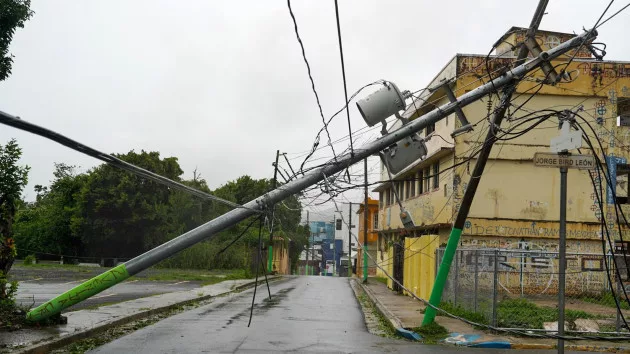(NEW YORK) — Puerto Rico is still recovering from Hurricane Maria — nearly seven years after the powerful Category 4 storm caused extensive damage to the island’s already delicate infrastructure.
September marks National Preparedness Month and the start of Hispanic Heritage Month — stark reminders of the work that remains to be done on the island, especially as climate change could lead to more rapidly intensifying hurricanes in the Atlantic Basin.
Getting Puerto Rico to the necessary storm preparedness is about “justice and fairness” in protecting a unique culture and heritage that belongs to the United States, Jorge Gonzalez-Cruz, professor at the University of Albany’s Atmospheric Sciences Research Center who has researched urban energy sustainability in Puerto Rico, told ABC News.
“We are U.S. citizens and deserve the best possible opportunity to develop and grow and have a sense of well-being and prosperity,” said Gonzalez-Cruz, who was born and raised on the island.
Hurricane Maria brought 155 mph winds as it made landfall near the city of Yabucoa, on the southeast portion of the island, on Sept. 20, 2017. The storm knocked out 95% of cell towers, leaving residents without the ability to communicate. Power, already scarce due to Hurricane Irma just weeks before, was knocked out on the entire island. Flooding on the island was rampant, with 13 locations reaching record flood stage, according to the National Oceanic and Atmospheric Administration. Structural damage to buildings was widespread, and nearly all road signs and traffic lights were destroyed, officials said.
Some communities were without power for up to a year, according to Gonzalez-Cruz.
Out of the nearly 3,000 deaths attributed to Maria, only dozens were as a result of the actual storm, Kyle Siler-Evans, senior engineer of RAND, a nonprofit research institute and public sector consulting firm, told ABC News. The rest of the fatalities were caused by lack of access to clean water, food and power for an extended period of time, he added.
The frequency of strong storms that impacted the U.S. in 2017 likely contributed to delays in response to Puerto Rico, Sally Ray, director of domestic funds for the Center for Disaster Philanthropy, told ABC News. Hurricane Harvey brought widespread flooding to the Houston area in August 2017. Hurricane Irma caused extensive damage in Florida after striking the Caribbean, including Puerto Rico, in early September 2017.
“By the time you got to Maria, you know, everybody had given all their attention and money to Harvey and not as much to the subsequent storms of that season,” Ray said.
The COVID-19 pandemic, subsequent storms that followed and the rise of inflation delayed the reconstruction even more, Siler-Evans said.
Puerto Rico was awarded $34 billion from the federal government for Hurricane Maria recovery efforts, $28.6 billion of which was allocated for permanent work and management costs, according to the Federal Emergency Management Agency.
As of September 2023, 86% of FEMA’s Projects for Puerto Rico, including hazard mitigation and management costs had been completed, according to FEMA.
Gonzalez-Cruz described recovery efforts as being at a “good pace,” despite the setbacks. Improvements continue to be made to the power system, new flooding zones are regularly identified and reconstruction is moving steadily across the island, he said.
Thousands of smaller projects, such as the building of baseball fields and repairs to roads and bridges, are currently in the works as well, Siler-Evans told ABC News.
“But, [there’s] still a lot of work to be done,” Gonzalez-Cruz said.
Puerto Rico is often in the bullseye of storm systems that generate in the Atlantic Basin, the experts said. Every extreme weather event to impact the island since 2017 has been a litmus test of what still needs to be done to modernize its aging infrastructure, much of which was built during the mid-20th century.
More than 30,000 homes still had damaged roofs — covered in blue tarp — in 2019 as Hurricane Dorian neared the island, but a direct hit was avoided due to a late shift in track. In 2020, one million customers were without power following back-to-back earthquakes. An explosion and subsequent fire at a substation left 900,000 customers on the island without power in June 2021. Another massive fire at a major power plant caused a massive outage for about 1.3 million customers in April 2022, followed by Hurricane Fiona in September of that year.
Fiona was considered the first big test of the improvements made on the infrastructure since Maria, Gonzalez-Cruz said. The entire island lost power following the impact of the Category 1 storm.
The most recent named storm, Hurricane Ernesto, caused significant flooding on the island and left 730,000 customers without power — about half the island — after striking the island last month, officials said.
“There’s this whole cycle of problems that happens after a storm like Ernesto that [doesn’t] get the attention,” Ray said.
The toll from the aftermath of Hurricane Maria took on the collective psyches of Puerto Ricans cannot be understated, Gonzalez-Cruz said.
“It also shocked the makeup of the Puerto Rican people,” he said. “It revealed a lot of challenges that the island has been dealing with over [the] years.”
FEMA, its federal partners and the Government of Puerto Rico continue working closely on the island’s unprecedented recovery mission, a FEMA spokesperson said in an emailed statement to ABC News.
“FEMA is committed to the work that lies ahead and to ensuring that this historic recovery will have a lasting, positive impact on future generations,” the spokesperson said. “As National Hispanic Heritage Month begins, FEMA is proud to mention that its Hispanic and Latino Employee Resource Group is one of the largest in the agency with nearly 1,000 members across the country, many of whom are Puerto Rican and are leading the island’s long-term recovery efforts.
A request for comment from the Puerto Rico Electric Power Authority was not immediately answered.
Copyright © 2024, ABC Audio. All rights reserved.

